Simplified Chinese 古文化街 | Hanyu Pinyin | |
 | ||
Similar | ||
Guwenhua Jie, Tianjin's Ancient Culture Street, is a cultural tourist attraction on the west bank of the Hai River in Nankai District, Tianjin, China. It is classified as a AAAAA scenic area by the China National Tourism Administration.
Contents
- Map of Gu Wen Hua Jie Nankai Qu Tianjin Shi China 300141
- Gu wenhua jie tianjin china
- Queen of Heaven Palace
- Yuhuangge Taoist Temple
- References
Map of Gu Wen Hua Jie, Nankai Qu, Tianjin Shi, China, 300141
Tianjin Ancient Culture Street was opened on New Year's Day in 1986. It preserves the architectural style of Qing dynasty, with its Niangniang Palace honoring the sea-goddess Mazu in the center. There are many stores along the street.
Gu wenhua jie tianjin china
Queen of Heaven Palace
The Queen of Heaven, Tianhou, or Niangniang Palace is a temple to the Chinese sea-goddess Mazu, a medieval Fujianese girl who was later deified. It is located in the middle of the Ancient Culture Street. Other names include "Niangniang" or "Tianhou Temple", the "Tianfei Palace", the "Xiaozhigu Tianfei Palace", and the "Western Temple".
The Niangniang Palace was first constructed in 1326 under the Yuan but has subsequently been repaired many times. The complex faces east with the Haihe River running in front. From the east to the west, the main buildings are the Opera Tower, the Flag Pole, the Temple Gate, the Memorial Archway, the Front Hall, the Main Hall, Canon-Storing Pavilion, the Qisheng Temple, the Bell-Drum Tower, the Side Hall, and the Zhangxian Pavilion. The Main Hall is constructed on a high and large platform, which is typical for wooden structures of the mid- to late Ming. The complex is one of the three major surviving Mazu temples in China and one of the oldest.
The main function of the temple is to pray for safe navigation. The palace was a center of marine sacrifice in the past dynasties and also a venue for sailors to have happy get-togethers. Besides ceremonial rituals held to worship the Goddess of the Sea, various performances are held to thank the goddess. It is said that the 23rd day of the third month of the Chinese lunar calendar is Matsu's birthday and a folk flower fair is held here annually to commemorate her on the day.
Yuhuangge Taoist Temple
Yuhuangge Taoist Temple was once the most famous building group in Hai River Triple Junction. In 2007, an ancient government road in Ming Dynasty was found, however large-scale excavation was not made due to architectural and other reasons.
A few days ago, many famous historians had special argumentation in respect of discovering historical and cultural resources of the Cultural Street, and improving the cultural landscape of Yuhuangge Taoist Temple. Around Yuhuangge Taoist Temple, there may be many historical relics and sites to be discovered. Experts advised the restoration of the museum held by historical Zhili Public Welfare Services in this Temple about one hundred years ago, forming the “Yuhuangge Historical Museum”.
Yuhuangge was built in Hongwu Years of Ming Dynasty, 1368 AD, and is one of the oldest buildings remaining in Tianjin.
